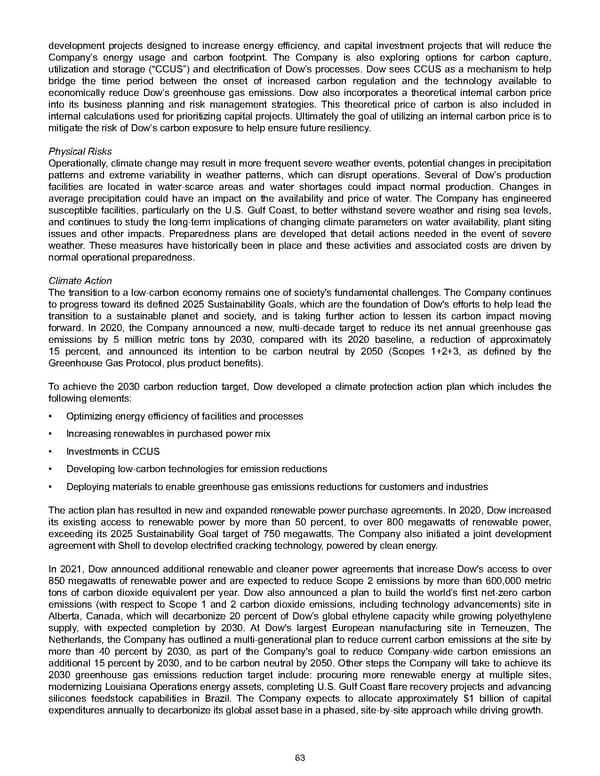development projects designed to increase energy efficiency, and capital investment projects that will reduce the Company’s energy usage and carbon footprint. The Company is also exploring options for carbon capture, utilization and storage (“CCUS”) and electrification of Dow’s processes. Dow sees CCUS as a mechanism to help bridge the time period between the onset of increased carbon regulation and the technology available to economically reduce Dow’s greenhouse gas emissions. Dow also incorporates a theoretical internal carbon price into its business planning and risk management strategies. This theoretical price of carbon is also included in internal calculations used for prioritizing capital projects. Ultimately the goal of utilizing an internal carbon price is to mitigate the risk of Dow’s carbon exposure to help ensure future resiliency. Physical Risks Operationally, climate change may result in more frequent severe weather events, potential changes in precipitation patterns and extreme variability in weather patterns, which can disrupt operations. Several of Dow’s production facilities are located in water-scarce areas and water shortages could impact normal production. Changes in average precipitation could have an impact on the availability and price of water. The Company has engineered susceptible facilities, particularly on the U.S. Gulf Coast, to better withstand severe weather and rising sea levels, and continues to study the long-term implications of changing climate parameters on water availability, plant siting issues and other impacts. Preparedness plans are developed that detail actions needed in the event of severe weather. These measures have historically been in place and these activities and associated costs are driven by normal operational preparedness. Climate Action The transition to a low-carbon economy remains one of society's fundamental challenges. The Company continues to progress toward its defined 2025 Sustainability Goals, which are the foundation of Dow's efforts to help lead the transition to a sustainable planet and society, and is taking further action to lessen its carbon impact moving forward. In 2020, the Company announced a new, multi-decade target to reduce its net annual greenhouse gas emissions by 5 million metric tons by 2030, compared with its 2020 baseline, a reduction of approximately 15 percent, and announced its intention to be carbon neutral by 2050 (Scopes 1+2+3, as defined by the Greenhouse Gas Protocol, plus product benefits). To achieve the 2030 carbon reduction target, Dow developed a climate protection action plan which includes the following elements: • Optimizing energy efficiency of facilities and processes • Increasing renewables in purchased power mix • Investments in CCUS • Developing low-carbon technologies for emission reductions • Deploying materials to enable greenhouse gas emissions reductions for customers and industries The action plan has resulted in new and expanded renewable power purchase agreements. In 2020, Dow increased its existing access to renewable power by more than 50 percent, to over 800 megawatts of renewable power, exceeding its 2025 Sustainability Goal target of 750 megawatts. The Company also initiated a joint development agreement with Shell to develop electrified cracking technology, powered by clean energy. In 2021, Dow announced additional renewable and cleaner power agreements that increase Dow's access to over 850 megawatts of renewable power and are expected to reduce Scope 2 emissions by more than 600,000 metric tons of carbon dioxide equivalent per year. Dow also announced a plan to build the world’s first net-zero carbon emissions (with respect to Scope 1 and 2 carbon dioxide emissions, including technology advancements) site in Alberta, Canada, which will decarbonize 20 percent of Dow’s global ethylene capacity while growing polyethylene supply, with expected completion by 2030. At Dow's largest European manufacturing site in Terneuzen, The Netherlands, the Company has outlined a multi-generational plan to reduce current carbon emissions at the site by more than 40 percent by 2030, as part of the Company's goal to reduce Company-wide carbon emissions an additional 15 percent by 2030, and to be carbon neutral by 2050. Other steps the Company will take to achieve its 2030 greenhouse gas emissions reduction target include: procuring more renewable energy at multiple sites, modernizing Louisiana Operations energy assets, completing U.S. Gulf Coast flare recovery projects and advancing silicones feedstock capabilities in Brazil. The Company expects to allocate approximately $1 billion of capital expenditures annually to decarbonize its global asset base in a phased, site-by-site approach while driving growth. 63
 Annual Report Page 72 Page 74
Annual Report Page 72 Page 74